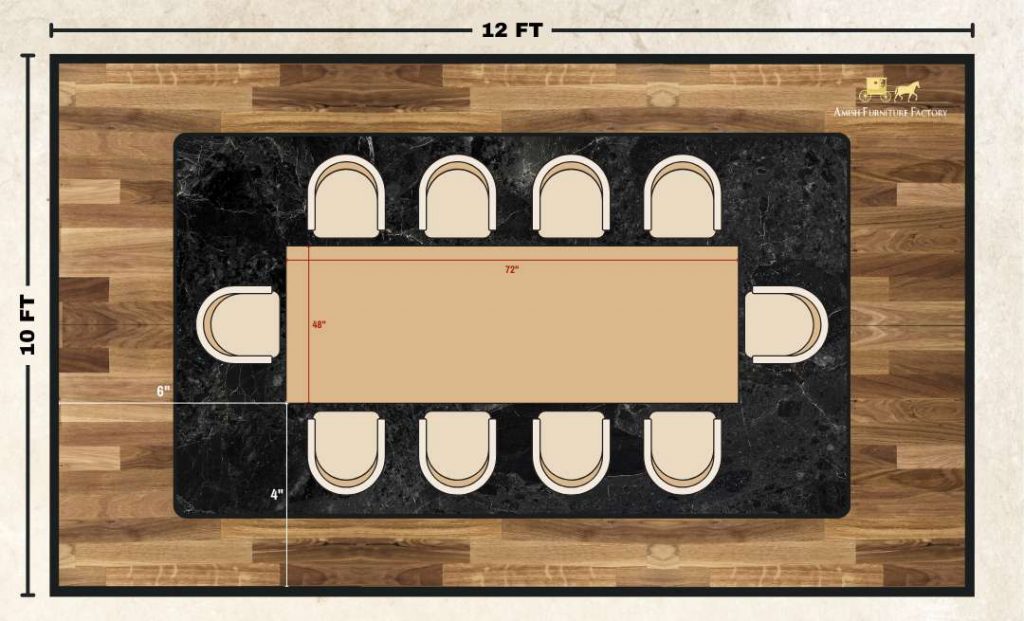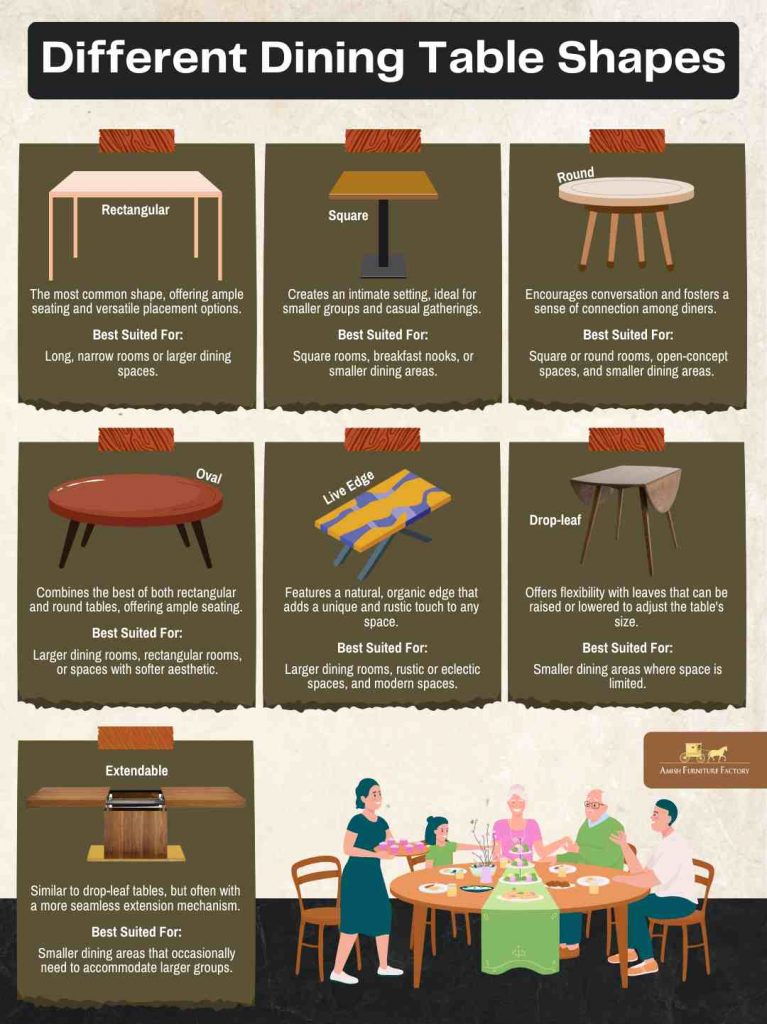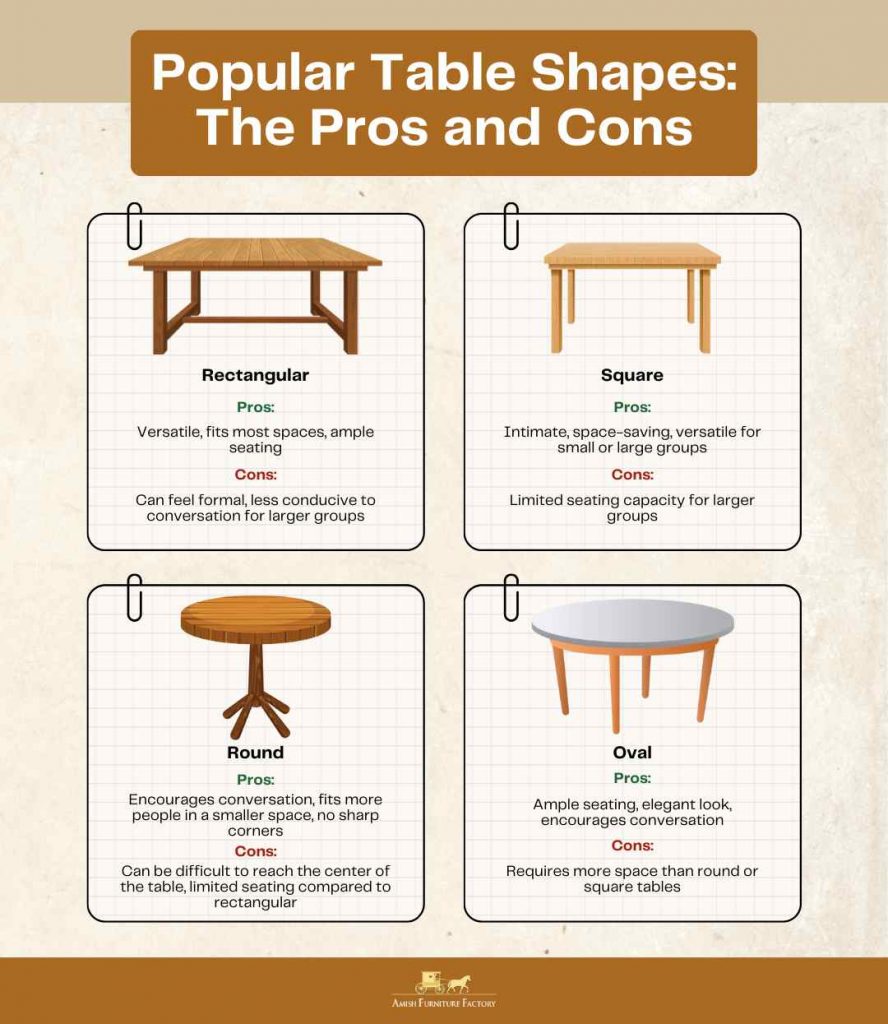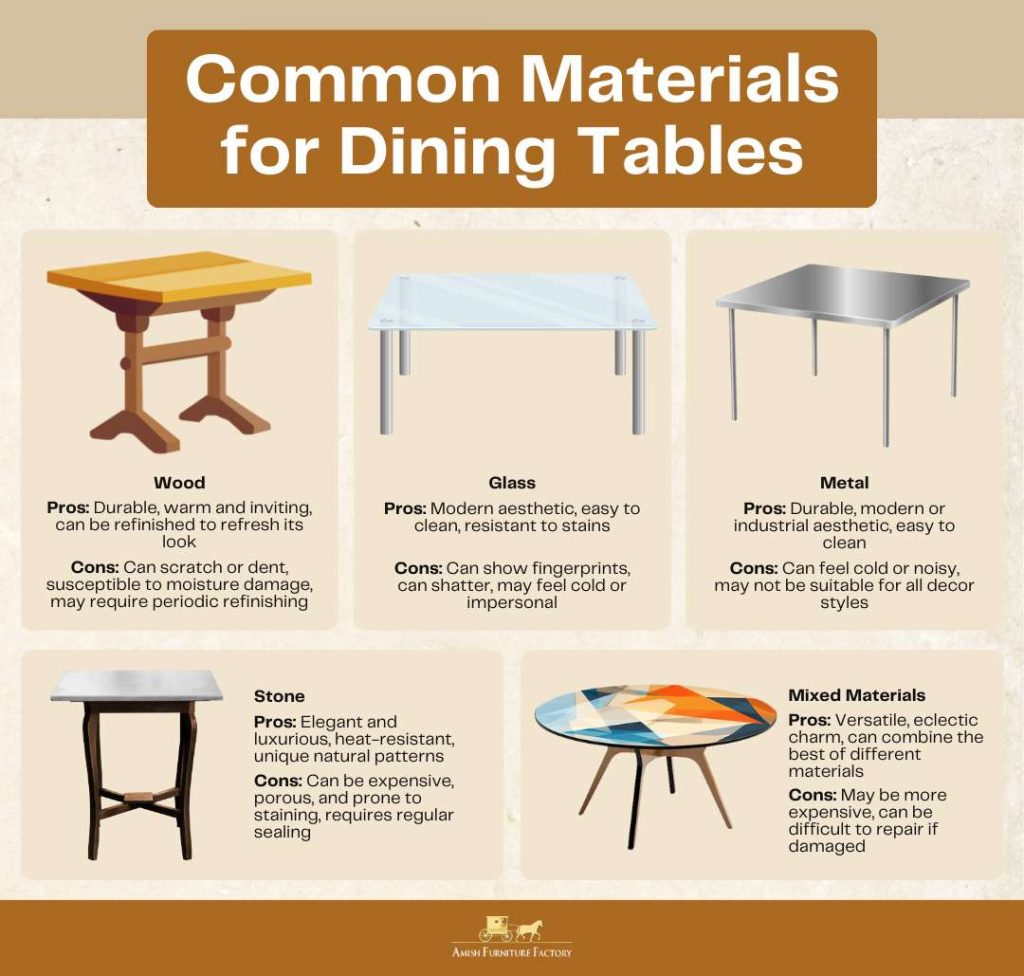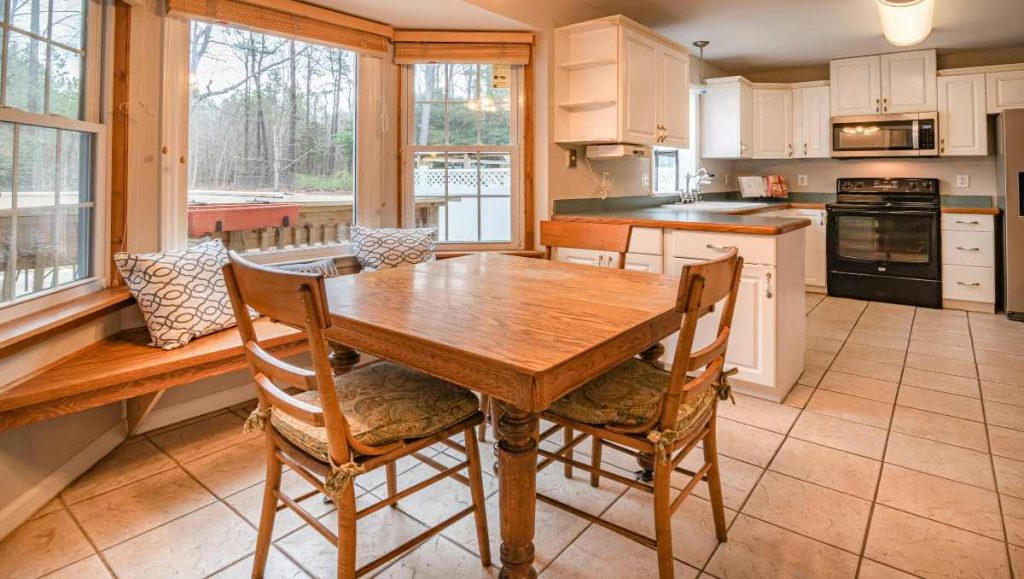
Far more than just a place to eat, the dining table serves as the heart of your home and a stage for countless gatherings. Choosing the right dining table is a crucial decision that can significantly impact your space’s overall feel and functionality. All too often, homeowners find themselves struggling with a table that’s either dwarfed by a spacious room or crammed into a tight corner. What exactly is the right dining table size for your home?
Key Takeaways
- Accurate measurements are the foundation of choosing the right table size. Ensure ample clearance around the table and chairs for comfortable movement.
- Determine how many people you’ll typically seat at the table for everyday meals and special occasions. Allow for 24-30 inches of space per person.
- The shape of your room influences table shape choices. Rectangular tables are versatile, round tables encourage conversation, and oval tables combine the best of both worlds.
- Wood offers warmth and character, glass creates a modern look, metal is durable and industrial, and stone exudes luxury. Mixed materials can add a unique touch.
In this guide, we’ll discuss the factors that influence table size selection, provide practical tips for measuring your space, and offer insights into choosing the ideal shape and style for your needs. Whether you’re furnishing a formal dining room, a cozy breakfast nook, or an open-concept living space, this guide will equip you with the knowledge needed to make an informed decision in choosing dining room furniture for your home.
Key Considerations Before You Buy a Dining Table
Before you go on your quest for the perfect dining table, laying a solid foundation is essential by considering several key factors. These considerations will ensure that your chosen table complements your space aesthetically and functions seamlessly in your daily life.
Room Dimensions
The first step in determining the right table size is accurately measuring your dining room. This includes not just the room’s length and width but also the ceiling’s height and any architectural features that might affect table placement. If your dining room is part of an open-concept layout, consider the overall flow of the space and how the table will interact with other furniture pieces.
In the United States, the average dining room size in new single-family homes is 14×16 feet. However, this is just an average, and dining room sizes can vary significantly depending on the home’s style, age, and location. Regardless of the average, measuring your own space is crucial to determine the maximum table size that will fit comfortably.
How to Calculate the Right Table Size
- Measure your dining room: Note down the length and width of the room in feet.
- Subtract for clearance: For comfortable movement around the table and chairs, subtract 6 feet from both the length and width measurements. This allows for approximately 3 feet of space on all sides of the table.
- Calculate table dimensions: Multiply the adjusted length and width measurements by 12 to convert them from feet to inches. The resulting numbers represent the maximum ideal length and width of your dining table in inches.
For example, if your dining room measures 12 feet by 10 feet:
- Adjusted length: 12 feet – 6 feet = 6 feet
- Adjusted width: 10 feet – 6 feet = 4 feet
- Maximum table length: 6 feet x 12 inches/foot = 72 inches
- Maximum table width: 4 feet x 12 inches/foot = 48 inches
This calculation gives you a good starting point for selecting a table size. Remember, this is just a guideline, and you can adjust the dimensions based on your personal preferences and the specific layout of your dining room.
Number of People
How many people do you typically seat at your dining table? Are you a small family who enjoys intimate meals, or do you frequently host large gatherings? Consider both your everyday needs and your occasional hosting requirements.
As a general rule of thumb, allow for approximately 24 inches of space per person along the table’s perimeter. This ensures that everyone has enough elbow room and can comfortably eat without feeling cramped. For those who enjoy hosting larger parties, an extendable or drop-leaf table can be a versatile solution, providing flexibility to accommodate varying numbers of guests.
Shape of the Room and Table
The shape of your dining room will naturally influence the shape of your table. For instance, a long, rectangular room typically pairs well with a rectangular or oval table, while a square room might be better suited to a round or square table. Consider the overall aesthetic you want to create and how the table shape will interact with the room’s proportions.
Your Lifestyle
How you use your dining table will play a significant role in determining the right size. If your dining room is primarily used for formal dinners, you might opt for a larger table that can accommodate multiple courses and elaborate place settings. Conversely, if your dining table doubles as a workspace or a family game center, a smaller, more versatile table might be a better fit.
By carefully considering these key factors, you’ll be well on your way to selecting a dining table that not only enhances the beauty of your space but also serves as a functional and enjoyable centerpiece for years to come.
Determining the Right Dimensions
Once you have a good grasp of the key considerations, it’s time to get into the specifics of determining the right dimensions for your dining table. This involves striking a balance between seating capacity, tabletop space per person, and legroom.

Tabletop Space Per Person
In addition to seating capacity, consider the amount of tabletop space each person needs. Aim for 24-30 inches of width per person to allow for comfortable elbow room and enough space for place settings, serving dishes, and centerpieces.
Expert Tip: If you frequently entertain, consider opting for a slightly larger table to accommodate extra dishes and table decorations.
Legroom
Legroom is another crucial aspect of dining table comfort. Ideally, allow for at least 18 inches of space between the seat of the chair and the bottom of the table apron or pedestal. This ensures that diners can stretch their legs comfortably and move their dining chairs without bumping into table legs. The type of table base you choose can also affect legroom. Tables with a pedestal base or trestle base typically offer more legroom than tables with four legs at the corners.
Popular Table Shapes and Their Benefits
The shape of your dining table not only influences its aesthetic appeal but also plays a significant role in how it functions within your space. Let’s explore the most popular table shapes and their unique benefits:
Rectangular Tables: These are the most common choice for dining rooms, and for good reason. They offer ample seating for larger groups, can be easily pushed against a wall to save space when not in use and come in a wide variety of styles to suit any taste. However, they can also feel a bit formal and less conducive to intimate conversations.
Square Tables: These are perfect for smaller spaces or intimate gatherings. They create a cozy and inviting atmosphere, encouraging conversation and connection among diners. For larger groups, two square tables can be combined to form a rectangle.
Round Tables: Known for their ability to foster conversation and create a sense of equality among diners. With no head of the table, everyone feels included and engaged in the conversation. Round tables also take up less visual space than rectangular tables, making them a great choice for smaller rooms or open-concept spaces.
Oval Tables: These tables combine the best features of rectangular and round tables. They offer ample seating for larger groups while still maintaining a softer, more elegant look. The rounded edges also create a more intimate and inviting atmosphere than a rectangular table.
Choosing the Right Dining Table Material
The material of your dining table is more than just an aesthetic choice; it also affects the table’s durability, maintenance requirements, and overall feel. Let’s discuss the most popular dining table materials and their unique characteristics:
Wood: Wood is a classic choice for dining tables, offering warmth, character, and a timeless appeal. It comes in a wide variety of species, each with its own unique grain patterns and color variations. Some popular choices include oak, maple, cherry, and walnut.
Glass: Glass tabletops offer a sleek, modern aesthetic that can make a room feel more spacious and airy. They are also easy to clean and resistant to stains and scratches. However, glass can be prone to fingerprints and may shatter if not handled with care.
Metal: Metal dining tables, often made of stainless steel, aluminum, or iron, offer an industrial chic look that can complement modern or eclectic decor. They are highly durable and resistant to scratches and dents, making them a great choice for busy households.
Stone: Stone tabletops, such as marble or granite, exude luxury and elegance. They are heat-resistant and add a touch of sophistication to any dining room. However, stone can be porous and prone to staining, requiring regular sealing and maintenance.
Mixed Materials: Combining different materials, such as a wood top with a metal base, can create a visually interesting and versatile dining table. This allows you to blend different styles and create a unique look that reflects your personal taste.
Conclusion: Setting the Table for Memorable Gatherings
Choosing the right dining table size is a decision that goes beyond mere aesthetics. It’s about creating a space where comfort, functionality, and style converge to enhance your everyday meals and special occasions. By carefully considering your room’s dimensions, the number of people you’ll typically seat, your lifestyle, preferred table shape, and material, you can confidently select a table that will serve as the heart of your home for years to come.
Remember, a well-chosen dining table is more than just furniture; it’s a place where memories are made, laughter is shared, and connections are forged. So, take your time, explore your options, and invest in a dining table that will bring joy and warmth to your home for generations.
Frequently Asked Questions
What is the best dining table size for a small apartment?
For small apartments, round or square tables are often the best choice as they take up less visual space and can be tucked into corners. A drop-leaf or extendable table can also be a great option, offering the flexibility to adjust the table size based on your needs. Consider a table with a diameter of 36-48 inches for smaller groups or a square table measuring 36-42 inches on each side.
How much space should be left around a dining table?
Aim for at least 36 inches of space between the edge of the table and any walls or other furniture. This allows for comfortable movement around the table and dining arm chairs. If your dining area is particularly tight, you might be able to get away with 30 inches of clearance, but any less will likely feel cramped.
Can I use a round table in a rectangular room?
Absolutely! A round table can add visual interest to a rectangular room and create a more intimate and conversational atmosphere. Just be sure to leave enough space around the table for people to move comfortably.
What is the most versatile dining table size?
A rectangular table measuring 72 inches long by 36 inches wide is often considered the most versatile size. It can comfortably seat 6-8 people and can be placed against a wall when not in use. Extendable tables offer even more versatility, allowing you to adjust the size based on your needs.
How to choose a dining table for a large family?
For larger families, a rectangular or oval table is often the best choice. Aim for a table that can comfortably seat everyone with ample elbow room (24-30 inches per person). If you have a large dining room, consider a table that measures 96 inches or longer. An extendable table can also be a good option, providing flexibility to accommodate guests for special occasions.

